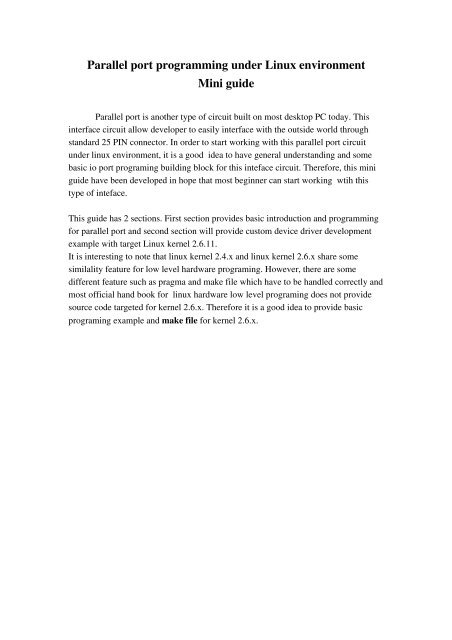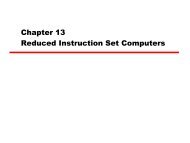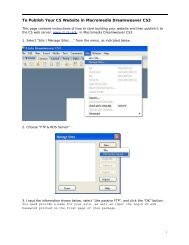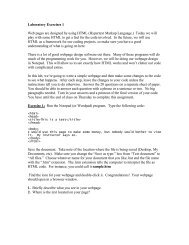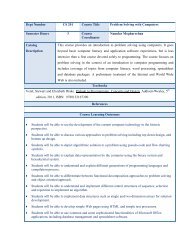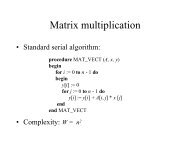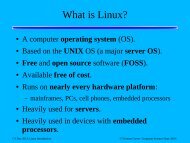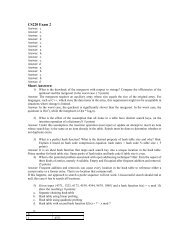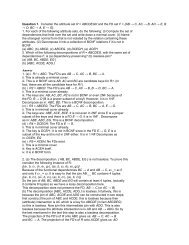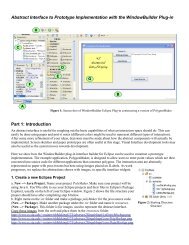Parallel port programming under Linux environment Mini guide
Parallel port programming under Linux environment Mini guide
Parallel port programming under Linux environment Mini guide
Create successful ePaper yourself
Turn your PDF publications into a flip-book with our unique Google optimized e-Paper software.
<strong>Parallel</strong> <strong>port</strong> <strong>programming</strong> <strong>under</strong> <strong>Linux</strong> <strong>environment</strong><strong>Mini</strong> <strong>guide</strong><strong>Parallel</strong> <strong>port</strong> is another type of circuit built on most desktop PC today. Thisinterface circuit allow developer to easily interface with the outside world throughstandard 25 PIN connector. In order to start working with this parallel <strong>port</strong> circuit<strong>under</strong> linux <strong>environment</strong>, it is a good idea to have general <strong>under</strong>standing and somebasic io <strong>port</strong> programing building block for this inteface circuit. Therefore, this mini<strong>guide</strong> have been developed in hope that most beginner can start working wtih thistype of inteface.This <strong>guide</strong> has 2 sections. First section provides basic introduction and <strong>programming</strong>for parallel <strong>port</strong> and second section will provide custom device driver developmentexample with target <strong>Linux</strong> kernel 2.6.11.It is interesting to note that linux kernel 2.4.x and linux kernel 2.6.x share somesimilality feature for low level hardware programing. However, there are somedifferent feature such as pragma and make file which have to be handled correctly andmost official hand book for linux hardware low level programing does not providesource code targeted for kernel 2.6.x. Therefore it is a good idea to provide basicprograming example and make file for kernel 2.6.x.
Section1: Introduction to parallel <strong>port</strong> <strong>programming</strong> <strong>under</strong> linux OSThe parallel <strong>port</strong>, sometime people call printer <strong>port</strong>, was originally designed tosup<strong>port</strong> connection interface between PC and printer device. Over last decade, thereare may external device that have been developed to interface with parallel <strong>port</strong>.These include scanner, removable device, data acquisition card, and medicalequipment etc.Nowaday, we can still find this parallel <strong>port</strong> connector on most of desktop PC.Physically, parallel <strong>port</strong> is 25 pin connector which provides 8 pins for bidirectionaldata lines, 4 pins for control lines and 5 pin for status input lines, and the less pin areall ground. This all together form a parallel <strong>port</strong> which can be accessed through a DB25 femal connector. Basically, there are four different type of parallel <strong>port</strong>. These are1. standard parallel <strong>port</strong> (SPP)2. simple bidirectional <strong>port</strong>3. enhanced parallel <strong>port</strong> (EPP)4. extended capailities <strong>port</strong> (ECP)<strong>Parallel</strong> <strong>port</strong> is originally designed to sup<strong>port</strong> only basic input output line seperatelywhich data and control lines are used for output and status lines are used for input.Later, there are 3 more different standard that have been developed to provide highercommunication speed and allow bidirectional use of data lines. For complete detail ofparallel <strong>port</strong> standard, please refer to www.fapo.com/1284int.htm.Most of modern computer now can be configured to operated in all of these 4 mode.By using bios setup, we can alter mode operation of parallel <strong>port</strong>.To get start working with parallel <strong>port</strong>, SPP mode is selected for this mini <strong>guide</strong>. It isnot the fastest operation mode but simple enough for beginer. For other differentmode please refer to website: www.lvr.com.<strong>Parallel</strong> <strong>port</strong> CharacterisiticFigure 1 illustrates picture of DB25 connectorFigure 1. illustrates DB25 connector, DB25 cable and DB25 breakout board
figure 2 ilustrates pinout of parallel <strong>port</strong>.Generally, parallel <strong>port</strong> circuit are directly designed to talk with PC mother boardthrough x86 ISA bus at I/0 address 0x378. In addtion, When writing C program, wecan read and write this parallel <strong>port</strong> via 3 software registers. These are Data register,Status register, and control register located at io addres 0x378, 0x378+1, and 0x378+2respectively. By writing or reading from these 3 registers we can input and outputdigital logic to the outside world. For SPP mode, we can write DATA and Controlregister to output logic signal. In addtion, we can read from Status register to obtainlogic input from the real world. In particular, all of 3 hardware register have beendesigned to connected with I/O bus of mother board and outputinput buffer ofparallel <strong>port</strong> circuit. When writing data byte to address 0x378 (data register), PC willgenerate proper control signal to to transfer data byte to output buffer on parallel <strong>port</strong>device. In turn, data byte on output buffer will be later converted into electrical logicsignal in which 5V is corresponding to bit =1 and 0V for bit =0. All of this steps istaken place within microsecond. It is im<strong>port</strong>ant to know exact information about pinmapping of parallel <strong>port</strong> that associate with each bit of those data registers.Table 1 provides information of relationship for PIN number, signal name andassociated data register.
Pin No (DType 25)Pin No(Centronics) SPP SignalDirectionIn/out RegisterHardwareInverted1 1 nStrobe In/Out Control Yes2 2 Data 0 Out Data3 3 Data 1 Out Data4 4 Data 2 Out Data5 5 Data 3 Out Data6 6 Data 4 Out Data7 7 Data 5 Out Data8 8 Data 6 Out Data9 9 Data 7 Out Data10 10 nAck In Status11 11 Busy In Status Yes12PaperOut /12 PaperEnd In Status13 13 Select In Status14nAuto14 Linefeed In/Out Control Yes15 32 nError / nFault In Status16 31 nInitialize In/Out Control17nSelectPrinter36 / nSelectIn In/Out Control Yes18 25 1930 Ground GndTable 1 lists particular DB25 pin associated 3 data register.
Programing parallel <strong>port</strong> <strong>under</strong> linuxI/O <strong>port</strong> operations with linux is simple. There are 2 basic comand to work with.First command is inb() and second is outb(). The following example illustrates howto perform input and output operation for parallel <strong>port</strong> in SPP mode.Exam 1.//file Name : Ex1.c#include #include void main(){ char a; //store 8 bit dataif(ioperm(0x378,3,1)) exit(1); //obtain hardware i/o access permission//at io address 0x378//kernel. If fail, exitoutb(0x0F,0x378)//write 1111 1111 to data line//where 1 represent logic higha = inp(0x378+1)//read data from input status register//at address 0x379print(“Hello parallel <strong>port</strong>\n”);}From above example, header file “asm/io.hJ” is needed for basic I/O access for linux.For output operation, we use outb command with first argument for data logic to bewritten and second argument for data register.For input operation, we can call inp command with specified i/o address of statusregister. Then logic value from outside world will be stored in to 'a' variable. Noticethat this example is simple way to interface with parallel <strong>port</strong>. However, there is somedisadvantage with this scheme. First, programmer need to keep track of individual bitof these 3 registers. Secondly, there are possiblity that multiple bash script file willtake control over these registers at the same time. One script may set first bit of dataregister while the other script clear first bit of data register. This somehow, scriptneed to be able to store and recall the last written byte value of registers. To overcomethis problem, custom device driver programing will be addressed in the section 2.
Code compilationBefore compiling any C code <strong>under</strong> linux, please make sure that there is GNU suitavialable in your system. Most of linux distribution have already provide this basicfeature for basic installation. However, developer may install GNU suit by themselfusing tarball or RPM file.Code compilation of example 1>> gcc o ex1 ex1.cThis will produce ex1 executable file. When running this program, console will showmessage “Hello parallel <strong>port</strong>”. This example also send out 0x0F to data register. Thismean that all data lines signal will have logic 1 signal at output. To observe thissignal, we can use osciloscope or simple multi meter to measure voltage signal of thisdata lines as depicted in figure 3.5 V
Section 2: Custom device driver programing<strong>Linux</strong> operating system allow us to develop custom hardware device driver to run inkernel space to provide following benefit.1. driver can be load and unload using loadable modules mechanisim.2. driver can be accessed through file operation.3. device driver operation is performed throught file operation in /dev directory.4. device driver can exist in /proc directory.5. device drive shield develop from interface logic specifics.6. /proc directory device fiels are created onthefly and do not collide with otherdevice file.In order to <strong>under</strong>stand basic <strong>under</strong>standing of custom device driver, please refer tohelloworld example's source code provided in appendix A. For more specific detail ofcustom device driver programing, please refer tohttp://www.xml.com/ldd/chapter/book/Compilation and Test process1. For kernel 2.6.x , please make sure that content of the make file is defined asfollow.Make file## Makefile for hello.c file#KDIR:=/lib/modules/$(shell uname r)/buildobjm:=hello.odefault:$(MAKE) C $(KDIR) SUBDIRS=$(PWD) modulesclean:$(RM) .*.cmd *.mod.c *.o *.ko r .tmp*
2. compile this device driver using follow command>> makeThis will create hello.ko3. insert modulelogin as root and then type following command>> insmod ./hello.koCheck for greeting message in log message>> tail /var/log/messagesYou will result similar to following messageAug 3 09:13:42 SmileBox kernel: Hello World Man !4. remove module>> rmmod hello.koThis will generate folllowing messageAug 3 09:18:48 SmileBox kernel: Good bye Dear friend!However, This example does not incoporate process file concept. In order to read andwrite to normal process file. We need to incorporate process handler feature insidehelloworld example. For this, h_proc example source code is provided in appendix A.For complete detail of process file programing example please refer tohttp://www.xml.com/ldd/chapter/book/After insert h_proc using insmod command. We can observed this module usingfollowing command>> ls /procThe list will include module my<strong>Parallel</strong>2 in the process file's listWe can read and write to process file using cat and echo command respectively.Example>> cat /proc/my<strong>Parallel</strong>2This generates message“Data buffer is 1234”>> echo “567” > /proc/parallel <strong>port</strong>This will write 567 to this process's file buffer>> cat /proc/my<strong>Parallel</strong>2this generates message“Data buffer is 567”From this example we can then apply this method to keep track of what last byte wordwere written to parallel <strong>port</strong>. This also make sure that we also obtained current statusof each bit of 3 registers.
Appendix A.Hello world device driver source code// file name: hello.c#include #include #include #include #define MODULE_VERSION "0.1"#define MODULE_NAME "My<strong>Parallel</strong>"//====================================/// Standard <strong>Parallel</strong> Port Definition ///====================================/#define SPPDATAPORT 0x378#define SPPSTATUSPORT (SPPDATAPORT +1)#define SPPCONTROLPORT (SPPDATAPORT +2)MODULE_LICENSE("Dual BSD/GPL");static int __init hello_init(void){ int i;unsigned char v;printk( "Hello World Man !\n");for (i=0;i
Source code file my<strong>Parallel</strong>.c//Author : Anan Osothsilp//Date : 7/10/05//Device driver for parallel <strong>port</strong> Module//#include #include #include #include #define MODULE_VERSION "1.0"#define MODULE_NAME "helloworld proc module"#define HW_LEN 8struct h_data_t{char value[HW_LEN+1];};// Process file Pointerstatic struct proc_dir_entry *h_file;// Data Variablestruct h_data_t h_data;//procedure: Readstatic int proc_read_hworld(char *page,char **start, off_t off, int count, int *eof, void*data){int len;//cast conversion from data > h_datastruct h_data_t *h_data = (struct h_data_t *)data;
len = sprintf(page, "Data buffer is %s\n",h_data>value);return len;}//procedure: Writestatic int proc_write_hworld(struct file *file, const char *buffer, unsigned long count,void *data){int len;struct h_data_t *h_data = (struct h_data_t *)data;if(count > HW_LEN)len = HW_LEN;elselen = count;if(copy_from_user(h_data>value,buffer,len)){return EFAULT;}h_data>value[len] = '\0';}return len;//Procedure: Initializationstatic int __init init_helloworld(void){int rv =0;//create proc entry and make it readable by all 0666h_file = create_proc_entry("my<strong>Parallel</strong>2",0666,NULL);if(h_file == NULL){return ENOMEM;}//set default value of data to Flyerstrcpy(h_data.value, "1234");
set process file field bith_file>data = &h_data;h_file>read_proc = &proc_read_hworld;h_file>write_proc = &proc_write_hworld;//h_file>owner = THIS_MODULE;printk(KERN_INFO "%s %s initialized\n", MODULE_NAME,MODULE_VERSION);return 0;}//Procedure: Exitstatic void __exit cleanup_helloworld(void){remove_proc_entry("my<strong>Parallel</strong>2",NULL);printk(KERN_INFO "%s %sremove\n",MODULE_NAME,MODULE_VERSION);}module_init(init_helloworld);module_exit(cleanup_helloworld);//MODULE_AUTHOR("Andy 14");//MODULE_DESCRIPTION("Helo w proc");EXPORT_NO_SYMBOLS;This short <strong>guide</strong> is developed by Anan Osothsilpemail: anan14@siu.eduPlease feel free to use for any project. If modifcation were made to this originaldocument, please also notify me or send me a copy. I would appreciate for that.Also there are more list of topic that may be useful for this <strong>guide</strong>. This includehardware circuit diagram and list of real world application using parallel <strong>port</strong> <strong>under</strong>linux <strong>environment</strong>, and GUI development for parallel <strong>port</strong> interfacing. For the time ofwriting this hand <strong>guide</strong>, those topic are not included. However, you may expect thenew version in the near future.


